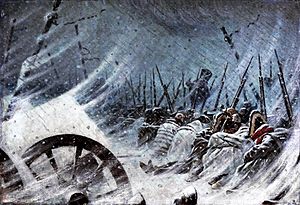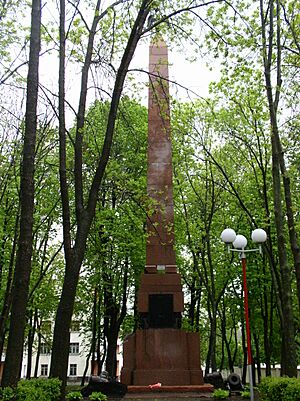Battle of Smoliani facts for kids
Quick facts for kids Battle of Smoliani |
|||||||
|---|---|---|---|---|---|---|---|
| Part of the French invasion of Russia | |||||||
 The night bivouac of Napoleon's army during the retreat from Russia. |
|||||||
|
|||||||
| Belligerents | |||||||
| Commanders and leaders | |||||||
| Strength | |||||||
| 30,000 troops | approximately 25,000 troops available; 6,000 involved on the 1st day; 5,000 involved on the 2nd day | ||||||
| Casualties and losses | |||||||
| 3,000 | 3,000 | ||||||
The Battle of Smoliani was a key fight during Napoleon's invasion of Russia in 1812. It happened on November 13–14, 1812. In this battle, Russian forces led by General Peter Wittgenstein defeated French troops under Marshal Claude Victor and Marshal Nicholas Oudinot. This battle was the last time the French tried to secure their northern battle line in Russia, known as the "Dwina Line." The French had already lost two battles in this area: the Second battle of Polotsk and the Battle of Czasniki.
| Top - 0-9 A B C D E F G H I J K L M N O P Q R S T U V W X Y Z |
Why the Battle of Smoliani Happened
After the French lost the Battle of Czasniki, Napoleon was very worried about his army in the north. He ordered Marshal Victor to attack General Wittgenstein and push the Russians back.
At this time, Napoleon was planning to lead his main army, the Grande Armée, to safety in the west, possibly towards Minsk. To do this, the path for his army's retreat had to be clear. Wittgenstein's army was positioned near Czasniki, about 31 miles (50 km) north of Borisov. Borisov was a town Napoleon needed to cross to get his army over the Berezina River and reach Minsk.
Marshal Victor was supposed to work with Marshal Oudinot's troops. Their first plan, approved by Napoleon, was to attack Wittgenstein from the side while another group attacked from the front. However, Oudinot insisted on a direct frontal attack, which changed the original plan.
French and Russian Army Morale
Before the Battle of Smoliani, the French commanders were not feeling very confident. They had poor plans, couldn't make up their minds, and were pessimistic because of their recent losses.
Many historians have criticized Oudinot and Victor for not trying to attack Wittgenstein from the side. Victor, in particular, was seen as unsure in his planning and how he carried out the attack. He had shown a tendency to retreat easily in earlier battles.
The mood among the Russian leaders was very different. In Wittgenstein's headquarters, there was a strong feeling of confidence and pride. This came from their repeated victories against the French. People described the atmosphere around Wittgenstein and his team as feeling "morally equal and often superior to the enemy." This might explain why Victor was hesitant to follow Napoleon's orders.
French Army Weakness and Challenges
The French army at Smoliani was also struggling because many soldiers were getting sick or dying. In the two weeks after the Battle of Czasniki, Victor's forces suffered a lot from the cold weather and diseases. By November 10, only about 25,000 troops were left under Victor's command. This gave Wittgenstein's army a clear advantage. The Russian troops were better supplied and protected from the harsh weather, so they didn't lose as many soldiers to illness or the cold.
The Battle Begins

The Battle of Smoliani started on November 13, in a nearby village called Axenzi. At first, the French had some success. General Louis Partouneaux led 6,000 French troops to attack General Alexiev's 6,000 Russian advance guard. Both sides lost about 500 soldiers in this fight. Even with more troops arriving, the Russians had to fall back to Smoliani.
The next day, November 14, the fighting became more intense. About 5,000 of Victor's French troops attacked and captured Smoliani. However, after this, the French attack failed. They were pushed back on the Russian right side and then lost Smoliani when Wittgenstein launched a counterattack. While this was happening, a small group of Russian soldiers managed to keep Oudinot's larger French force busy at the village of Poczavizi. This stopped Oudinot's troops from helping Victor.
The battle ended with both armies back in their original positions. Both sides suffered similar losses, with about 3,000 soldiers killed, wounded, or captured. However, the French were definitely in a worse situation. The next day, November 15, Victor retreated about 20 miles (32 km) south to Chereja.
What Happened Next
Even though Wittgenstein didn't chase the French right away, his victory meant he could still attack the Grande Armée when it passed through Bobr. This town was about 40 miles (64 km) south of Wittgenstein's position near Czasniki. The retreat of Victor and Oudinot, facing this big threat to Napoleon's main army, was another major setback for the French leader. The Battle of Smoliani also permanently ended any hope the French had of rebuilding their northern "Dwina Line."
See also

